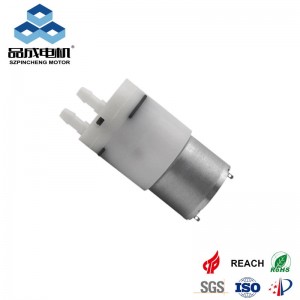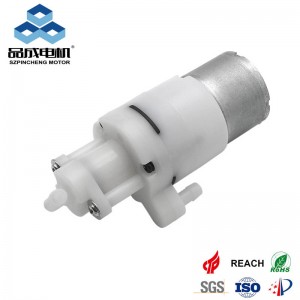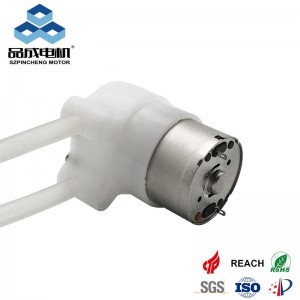Miniature DC diaphragm vacuum pumps represent a pinnacle of precision engineering—devices no larger than your palm yet capable of generating vacuum levels rivaling industrial-scale systems. These silent workhorses power critical applications from portable medical diagnostics to semiconductor manufacturing, where compact size, oil-free operation, and reliability are non-negotiable. At their core, they convert electrical energy into pneumatic force through an elegantly simple but mechanically sophisticated process.
How It Works: The Physics of Miniaturized Vacuum
The operational principle hinges on diaphragm oscillation driven by a DC motor. When powered, the motor’s rotary motion is converted into linear reciprocation via a cam or linkage mechanism. This rapidly flexes a polymer diaphragm, altering the pump chamber’s volume in two phases:
-
Intake Stroke: As the diaphragm retracts, chamber volume expands, creating a pressure differential (typically -50 to -90 kPa). Atmospheric pressure forces gas through the inlet valve, which opens under vacuum suction 19.
-
Exhaust Stroke: The diaphragm pushes forward, compressing the gas. Inlet valve seals shut, while exhaust valve opens, expelling gas against ambient pressure 37.
Unlike rotary vane pumps, this oil-free mechanism ensures zero contamination—critical for medical or analytical instruments. Diaphragm pumps also tolerate particulate-laden or humid gases without damage, a key advantage in environmental sampling 29.
Breaking Down the Key Technologies
1. Diaphragm & Valve Systems: The Heartbeat of Reliability
The diaphragm’s material dictates chemical compatibility and lifespan. Industry leaders use:
-
PTFE (Teflon®): For aggressive chemicals (acids, solvents) up to 150°C 1810.
-
Fluorocarbon Rubber: Balances flexibility and moderate chemical resistance 2.
-
Sandwich Composites: PTFE layers reinforced with elastomers enhance durability while preventing pinhole leaks—VACUUBRAND’s “PTFE sandwich” achieves >15,000-hour lifespans 8.
Valves employ flap or ball designs in PTFE or FFPM. Their precise actuation timing ensures minimal backflow (<10^-7 Pa·m³/s leakage rates), maintaining stable vacuum under variable loads 59.
Table: Material Selection for Critical Components
| Component | Material Options | Key Properties |
|---|---|---|
| Diaphragm | PTFE, FFPM, Fluororubber | Chemical inertness, fatigue resistance |
| Valve Seats | PTFE, PVDF | Low adhesion, rapid sealing |
| Pump Body | PPS, Aluminum, Stainless | Lightweight, corrosion resistance |
2. Motor & Drive: Precision in Motion
Brushed DC motors dominate for cost-effectiveness, but advanced pumps adopt brushless DC (BLDC) systems for:
-
Longer Lifespan: Eliminating brush wear extends operation to 8,000+ hours 5.
-
Adaptive Control: Integrated sensors modulate speed based on real-time pressure feedback, slashing power draw by 30% in battery devices 79.
-
Load Tolerance: Specially wound stators withstand pulsating torque demands—unlike standard BLDC motors for fans 5.
3. Fluid Dynamics & Acoustics
Micro-scale flow paths demand CFD-optimized geometries. Features include:
-
Tapered Chambers: Reduce dead volume for faster evacuation.
-
Helical Flow Channels: Dampen pulsation noise below 45 dB 39.
-
Integrated Dampers: Absorb pressure spikes during valve switching.
Pinmotor’s Engineering Edge: Case Study in Innovation
Pinmotor (www.pinmotor.net) exemplifies next-gen pump design. Their PCF-Series pumps leverage:
-
BLDC-Synced Diaphragm Actuation: A patented linkage reduces lateral diaphragm stress, boosting lifespan to 20,000 hours.
-
IoT-Ready Architecture: Built-in RS485/CAN bus enables remote diagnostics and pressure profiling for Industry 4.0 systems.
-
Corrosion-Resistant Build: Full PTFE fluid path handles acidic vapors (e.g., semiconductor etching residuals).
Performance Comparison: Pinmotor vs. Conventional Models
| Parameter | Pinmotor PCF-12V | Standard Pump |
|---|---|---|
| Max Vacuum | -92 kPa | -70 kPa |
| Flow Rate @ 0 kPa | 8 L/min | 5 L/min |
| Noise Level | 38 dB(A) | 50 dB(A) |
| Chemical Resistance | Full PTFE path | Partial sealing |
Where Miniature Vacuum Makes a Macro Impact
-
Medical Devices: Portable ventilators using oil-free vacuum ensure patient safety 7.
-
Environmental Sensors: Pinmotor pumps enable UAV-mounted air samplers detecting PM2.5/volatile organics.
-
Lab Automation: -80 kPa vacuum in compact footprint accelerates high-throughput filtrations 19.
-
Electronics Manufacturing: Moisture-free soldering with 99.9% vapor removal in PCB assembly lines.
Future Frontiers: Smart Pumps & Sustainable Tech
Emerging trends include:
-
AI-Optimized Maintenance: Vibration sensors predict diaphragm failure months in advance.
-
Green Materials: Bio-based diaphragms (e.g., reinforced PEF) for reduced microplastic shedding.
-
Hydrogen Compatibility: Seals redesigned for H₂ fuel cell recirculation—Pinmotor’s H2-Series achieves <1 ppm leakage.
Conclusion
From diaphragm chemistry to adaptive motor controls, miniature DC vacuum pumps encapsulate multidisciplinary innovation. Brands like Pinmotor push boundaries with smarter, tougher designs—proving that big vacuum power can indeed come in microscopic packages. As wearables and portable tech proliferate, these pumps will quietly enable the next leaps in health, science, and sustainability.
For engineers: When specifying a micro-diaphragm pump, prioritize dynamic seal integrity, BLDC efficiency, and full-path chemical resistance. The upfront cost premium pays back in years of zero-maintenance operation.
you like also all
Read More News
Post time: May-28-2025




